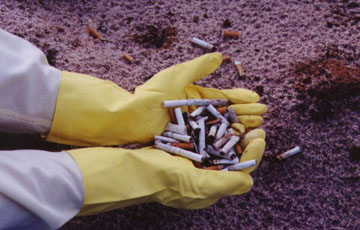Scientists propose to make a coating for the electrodes of supercapacitors from cigarette butts

Cigarette butts - the most common garbage.
South Korean scientists have proposed a technology to improve the performance of supercapacitors, which simultaneously reduces the amount of garbage. They managed to convert cigarette butts into carbon material, superior in properties to the current materials used in power supplies. Their work was published in the journal Nanotechnology.
Carbon, as an inexpensive, well-conducting current and having a large surface area, is used to coat electrodes in batteries. To improve work efficiency, it is necessary to improve any of the characteristics of this coating. Researchers all over the world are working to increase the energy intensity and stability of IP.
“Our research showed that used cigarette filters can be turned into high-performance carbon materials using a simple process in one step. Such technology at the same time increases the availability of energy and improves the environment, ”co-author of the work, Professor Lee Jonhop from Seoul State University, shared his joy. - Many countries are working to ban the use of toxic and non-biodegradable cigarette materials that pollute the environment. Our method is one of the methods to avoid environmental pollution. ”
According to some estimates, every year people throw out more than 750 thousand tons of cigarette butts. This is one of the most common types of garbage that we encounter in everyday life. A cigarette decays only after 5-7 years.
Scientists have taken advantage of the fact that almost all cigarette filters contain cellulose acetate fibers. Using pyrolysis technology, that is, thermal decomposition of organic natural compounds with a lack of oxygen, they obtained a very porous material with a large surface area.
“A high-performance material for supercapacitors should have a large surface area that can be achieved with porous materials,” the professor explains. “The combination of pores of various sizes provides greater energy intensity - a fundamental characteristic of a supercapacitor, which must be quickly charged and discharged.”
After making the material, scientists tested it in real work and found that its efficiency was higher than that of its analogues - industrial carbon coating, graphene or carbon nanotubes.
